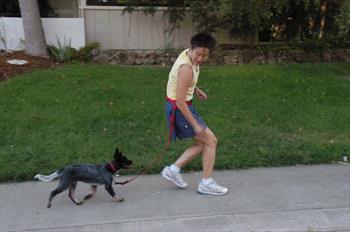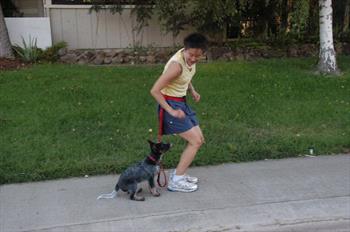One of the major issues with teaching dogs to walk well on lead is that they want to rush ahead to see the sights. Walking next to you, and especially stopping to wait, is boring to them compared to exploring. How do we remedy the situation? We make sticking next to you and stopping a fun game—one that’s as exciting as the people, sounds and smells on a walk.
In this blog, we’ll do this by working on an exercise I call “Repeat Sits on the Left Side.” I’ll show two variations—one with a lure and one with what I call a flash lure.
Repeat sits on the left side (or right side) using a lure.
This version of repeat sits on the left side is for dogs who are likely to be tentative and lag instead of sprinting forward when you start walking.
Start with your dog in heel position (refer to the blog on going back to heel to see how to get her here). Your arms should be bent about 90° and centered around your belly button. Sequentially give 1–3 treats to Fido for remaining seated. When you deliver, remember to avoid bending forward. Also be sure to simply straighten your arm and bend your knee as needed so that you are low enough to be at her level. The reward should come quickly (ideally within 1/5 of a second) so that she knows to keep her eyes peeled lest she blink and miss the delivery!
Treats should come at irregular intervals so that Fido is always looking at you in suspense.
Then start walking forward at a brisk speed (generally 2 steps per second) so it’s clear you are leading her forward. To help your pooch know to follow with you, hold a treat at the dog’s chin level as you speed forward. Note that if you hold the treat too high, your pooch won’t see it and then won’t follow.
Once your pooch is about to catch up to your hand, stop within a step or two. Notice that I’ve stopped soon enough so that this dog is slightly behind me when I stop.
Once the dog comes to a complete stop, raise the treat lure so that it’s clear she won’t get it until she sits. Generally when dogs are first learning this exercise, they won’t sit until you raise your hand because they’re so engrossed in the food that they are just thinking about getting the food. By raising your hand, you make it clear that they have to try a different behavior. Since this dog has been rewarded so much for sitting already, her default behavior when she wants something is to sit.
Once she’s sitting, reward her with the treat within half a second (before she gets up). Then stand up straight and give her 1–3 additional treats when she remains seated at your side so that she continues to remain seated at your side. If she already consistently remains at your side, you can just walk on.
Heeling with flash lure.
If your puppy or adult dog is already good with a regular lure (sometimes this just takes several trials) or she tends to want to sprint past you, you can use what I’ve dubbed a flash lure. It is often easiest to practice this in the house next to a wall so she can’t scoot away from you or run by.
Start by rewarding your pooch at irregular intervals for remaining seated in heel position. The treat should be delivered within 1/5 second so the delivery is fun and keeps the pup looking up at you.
Next walk forward briskly (120 beats/minute) so that you’re ahead of the puppy. Sometimes the faster you walk or run, the more fun it is for the puppy, but if you go too quickly the puppy may become overly excited and grab the leash or start nipping. So you may need to start by just going 1–3 steps.
Before the puppy catches up to you, and as you are planting your foot to stop, place your treat hand out at the dog’s chin level. This movement must be fast, like shoving a really yummy pie into her face. It will catch her attention and get her to immediately stop, even though she may have run right into it. Note here that my hand must go down a step before I stop. Also notice that my body weight is distributed back as I slow down. Some people accidentally lean forward, which tells their dog to sprint ahead.
Notice that my feet are together because I have stopped. My hand is actually further back than my heel and my shoulder is turned slightly towards the dog. That way she can’t run by me. Once she’s stopped, I DO NOT GIVE HER THE TREAT.
Instead, I raise the lure so it’s clear to her that she doesn’t get the food reward until she sits.
Once she sits, reward her with 1–3 sequential treats. The first is for sitting, the rest are for remaining seated next to you instead of just getting up. Note that, between treats, I stand up straight so that she learns to remain seated next to me when I’m standing with a normal upright body posture. If you continue to bend between treats, it’s like she’s getting one long treat rather than individual treats for remaining seated.
Next walk on briskly again for 1–3 steps and repeat. The goal is that you walk quickly enough so that she can follow you at a trot and that you stop every 1–3 steps at first until she gets the idea—meaning she stays by your side and stops every time. Once your technique is clear, your puppy or adult dog will be able to pick this up within just one or two 10-minute sessions. The next step is to increase the distance you walk to 5–7 steps prior to using the flash lure. Make sure you’re walking briskly. You can even sprint and suddenly stop. That makes the game even more fun for energetic, playful dogs.
The flash lure can be tricky. Here are some common errors.
Incorrect: In this case I incorrectly let Lucy push my hand forward instead of my keeping my hand in position next to or slightly behind me.
Here’s a close-up of the same mistake.
When your pup is at these stages, your walks should be short since the entire walk should consist of your puppy walking correctly. For Lucy, that meant 1–2 block walks her first several days. For my dad, that means only a walk around the block for her first several weeks with him.
Repeat sits without a lure.
Of course you don’t want to use a lure of any type for the rest of Fido’s life. In fact, we want to fade it out as soon as we can. For the majority of dogs, once your technique is polished, this process of weaning can take place within the second or third 10-minute practice sessions. However, you may still need to go back to the flash-lure temporarily during more distracting situations.
Fading out the lure or flash lure is simple. Once your puppy or adult dog has the exercises down with the flash lure, just intermittently try the exercises without the flash lure. Again, practice next to a wall first so that she sits straight and doing so becomes a habit.
As usual, keep your pup focused on you sitting in heel position first, especially when a distraction is going by.
Then walk forward at a brisk pace so that you send a clear message to your pup that you are now moving forward.
As with the flash lure, stop abruptly so it’s clear to the pup that you are stopping. Be sure to lean backwards a little when you suddenly slow down just as you would if you were sprinting and suddenly stopped. This body language makes it clearer to the dog what you are doing.
If she’s ready for this step, she’ll automatically stop and sit next to you. Because she had practiced sits a lot in the house, Lucy automatically sat whenever I stopped, even on the first several walks we took.
If she looks away once seated, you can make a clucking or smooching sound to get her to look back at you. At first, reward her every time you stop. When she can sit consistently whenever you stop, then reward intermittently so she’s on the gambler’s schedule of reinforcement.
Reward attention while walking.
Ultimately you don’t want to have to stop every 5–10 steps when walking. So as soon as you perform the techniques shown above, you can start rewarding the puppy as she walks and looks at you.
You can either wait until she looks at you for 1–2 steps while you’re walking or you can smooch to get her to look at you. Give her a treat while you are still walking. At first, reward her for just looking at you for 1–2 steps. When she can do this 5 times in a row, increase to 3–5 steps, then 5–7 and then 7–10, then ½ a block to a block of attention. It’s important to quickly raise your expectations and require she look at you for longer periods of time for the same level of reward if you plan to wean her off treats.
Add variety to keep the walk fun.
Walking briskly is fun for most dogs, especially if they are getting rewarded at the right intervals for their training level and for the distraction level of the environment. What makes the walk even more fun is the addition of variety. Remember to add in about-turns and U-turns to keep the walk interesting. Also, add in sudden fun changes of speed. That is, walk at a normal brisk pace and then suddenly speed up for 3–5 steps, then walk at a normal speed again. Reward when she catches up. Keep walking when you reward during this type of speed change. You can also slow down suddenly for 3–5 steps and reward right before you go back to a normal pace. And, of course, randomly add in the repeat sits on your left side.





















